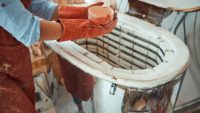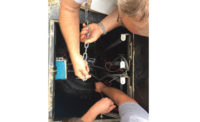My grandparents lived in Saint Clair, Pennsylvania, which is in the heart of the anthracite coal region. Pop-Pop had a Westinghouse Appliance store and serviced everything they sold. In addition, he had helped to wire homes when electricity first became available and serviced lots of coal boilers. As a young lad, I often tagged along on his service calls and virtually every home had coal boilers. Cleaning out the ash pits was one of my duties and learning how to tend a coal fire became routine.
Fast forward to the early 1980s where I had my own mechanical contracting business and successfully carved out a niche installing and servicing wood and coal boilers. Farmer Brown contacted me to ask if I would take a look at a recently installed coal boiler that wasn’t living up to the stated claims in the manufacturer’s literature. Brown wanted to know if it was installed properly.
The installation was letter-perfect from a hydronics perspective and in compliance with the manufacturer's installation manual. It was obvious the installer took pride in workmanship, as all the copper lines were straight and level. Every solder joint had been carefully wiped before the solder solidified and after the joints had cooled, the installer had cleaned all of the piping to remove and flux residue. The heavy-duty smoke pipe was properly sized with three screws in each joint installed in a wye pattern. Professionally installed and beautiful to behold from my perspective.
I asked farmer Brown if he had always used coal for heating. He told me this had been his parent’s home, and his father had taught him how to tend a coal fire from a very young age. That settled, it was time to study the manufacturer's literature. The boiler had a capacity to hold 40-pounds of coal and the literature claimed the boiler would provide 150,000 Btu/h for 24-hours before needing to add more coal. Brown told me he had to add coal in the morning, noon, evening and middle of the night when the weather turned cold. Checking the parts diagrams revealed nothing was missing internally.
My training from Eshland Boiler Co. had included some basic facts regarding coal. Pure anthracite coal would have 14,400 Btu per pound, but there is no such thing and, at best, we will find the actual value is around 12,000 Btu per pound. That’s where the clinkers in the ash come from. Coal providers know the actual Btu content of the coal they deliver and Farmer Brown’s coal was 12,220 Btu per pound. 40 pounds x 12,220 = 488,800 Btu, but we need to account for actual operating efficiency. Assuming an 80% efficiency, that net output is reduced to 391,040 Btu, and if Brown restricted combustion air to have the coal fire last for 24-hours, his net output would be 16,293-Btu/h for a drafty old farmhouse that had a 120,000 Btu/h heat loss at 10° F outdoor ambient air conditions with moderate winds. No wonder he was upset: He needed to add coal every three hours! Aside from having a full-time day job, Brown also worked the 200-acre farm, so he really didn’t have the time to deal with this aggravation. Brown asked me to write up a report ASAP and paid me for my time. I gave him some Eshland coal boiler literature and told him to contact me if he was interested.
Farmer Brown requested a meeting with the mechanical contractor, local wholesaler and the manufacturer’s representative after receiving my report. Brown told me the meeting did not go well. The manufacturer’s representative dismissed my report, and at one point, turned to the contractor and wholesaler to say: “Obviously the owner doesn’t know how to burn coal.” Brown was now furious and told me all he really wanted was an apology, but now he was fighting mad.
He contracted with me to install an Eshland coal boiler with a 300-pound coal capacity. At 80% operating efficiency, that yields 2,932,800 Btu and, if we assume a steady heat loss of 120,000 Btu/h, would hold a fire for 24 1/2 hours. With a 40-gallon water jacket, there would be plenty of heating capacity. The combustion air dampers were automatically controlled by a hydraulic aquastat to maintain temperature within the water jacket. Farmers, in general, represented the majority of my wood and coal boiler installations and were always willing to lend a hand moving these exceptionally heavy beasts into the basements and Brown was no exception. As a result, I almost never had to hire extra hands for the installations. Brown reported back a few days later to let me know how pleased he was with the new boiler and its performance.
Brown also gave me a heads up that he was going to sue the supply house and manufacturer. I received my subpoena and showed up at the appointed time in the courthouse. The manufacturer had flown two lawyers in from New York and the supply house had retained local counsel who, as it turned out, was one of my customers. Brown’s lawyer submitted my report as evidence and I was placed on the stand to be grilled by the New York lawyers. No need to lie when the facts cannot be denied and the judge, as it turned out, also heated his home with coal and was very familiar with the facts regarding Btu content per pound of coal.
I had asked Brown’s attorney to query me about the other mechanical contractor’s installation. That got him off the hook for bearing any part of the blame because, after all, he had gone to the wholesaler with the home’s Btu heat loss calculation and asked for a coal boiler that would meet Brown’s needs.
Brown received a judgment for the full amounts of the original installation and the cost for my initial investigation along with the amount Brown had paid for my installation and Eshland boiler.
Farmer Brown became a decades-long customer and recently lamented the fact that he was too old to be shoveling coal and tending the fire. Leaping into the 21st century, Brown had us install inverter heat pump mini-splits. The old coal boiler sits contentedly in the basement with several tons of coal so that, as Brown put it, when he passes on, the new owners will have the option of utilizing the mini-splits and/or firing up the coal boiler. For my aging back, I was grateful we didn’t have to remove Big Bertha!




